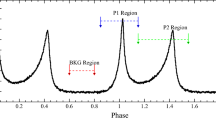Abstract
A principally new, quantitative system of the classification of the spectra of planetary nebulae is proposed. Spectral class of excitation class of the nebulap is determined according to the relative intensities of emission lines (N 1+N 2) [OIII]/4686 HeII and (N 1+N 2) [OIII]/Hβ (Table I, Figure 1). The excitation classes are obtained for 142 planetary nebulae of all classes—low (p=1–3), middle (p=4–8), and high (p=9–12+) (Tables II, III, and IV). An empirical relationship between excitation classp and mean radius of nebulae\(\bar R_n \) is discovered (Figure 2). This relationship as well as excitation classp, as an independend parameter, admit an evolutionary interpretation. It is shown that after reaching the highest class of excitationp=12+ the nebulae decrease their class of excitation with the further increases of sizes. The diagram of this relationship\(p \sim \bar R_n \) has two nearly-symmetric branches — rising and descending with the apogee onp=12+ (Figure 2).
Similar content being viewed by others
References
Aller, L. H.: 1956,Gaseous Nebulae, Chapman and Hall, London.
Bianchi, L.: 1987,Astron. Astrophys. 181, 85.
Bowen, I.: 1928,Publ. Astron. Soc. Pacific 67, 1.
Cannon, A. J.: 1916,Harvard Ann. 76, 20.
Daub, C. T.: 1982,Astrophys. J. 260, 612.
Feibelman, W. A., Oliversen, N. A., Nichols-Bohlin, J., and Gerhart, M. P.: 1989,IUE Spectral Atlas of Planetary Nebulae, Central Stars, and Related Objects, NASA Ref. Publ. 1203.
Gieseking, F., Hippelein, H., and Weinberger, R.: 1986,Astron. Astrophys. 156, 101.
Gurzadyan, G. A.: 1969,Planetary Nebulae, Gordon and Breach, New York.
Gurzadyan, G. A.: 1988,Astrophys. Space Sci. 149, 343.
Gurzadyan, G. A., Egikyan, A. G., and Terzian, Y.: 1991,Astrophys. Space Sci. 176, 9.
Hippelein, H. and Weinberger, R.: 1990,Astron. Astrophys. 232, 129.
Kaler, J. B.: 1976,Astrophys. J. Suppl. Ser. 31, 517.
Kaler, J. B.: 1981,Astrophys. J. 250, L31.
Kaler, J. B.: 1983,Astrophys. J. 271, 188.
Kaler, J. B.: 1987,Astron. Astrophys. 181, 86.
Maciel, W. J.: 1984,Astron. Astrophys. Suppl. Ser. 55, 253.
Page, T.: 1942,Astrophys. J. 96, 78.
Sabbadin, F.: 1984,Astron. Astrophys. Suppl. Ser. 58, 273.
Sabbadin, F., Strafella, F., and Branchini, A.: 1986,Astron. Astrophys. Suppl. Ser. 65, 259.
Seaton, M. J.: 1978,Monthly Notices Roy. Astron. Soc. 185, 5P.
Weinberger, R.: 1989,Astron. Astrophys. Suppl. Ser. 78, 301.
Author information
Authors and Affiliations
Rights and permissions
About this article
Cite this article
Gurzadyan, G.A., Egikyan, A.G. Excitation class of nebulae—An evolution criterion?. Astrophys Space Sci 181, 73–88 (1991). https://doi.org/10.1007/BF00644114
Received:
Issue Date:
DOI: https://doi.org/10.1007/BF00644114




